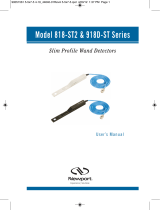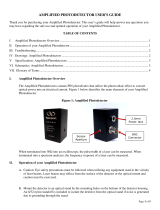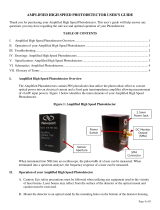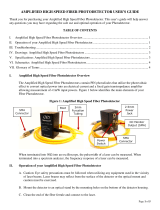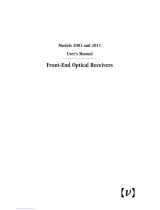Page is loading ...

Model 918D Series
Photodiode Detectors
Use r ’s M a n u a l
44640-02RevD 5-5x7-5_44640-01RevA 5-5x7-5.qxd 8/12/10 3:15 PM Page 1

44640-02RevD 5-5x7-5_44640-01RevA 5-5x7-5.qxd 8/12/10 3:15 PM Page 2

Model 918D Series
Photodiode Detectors
Dear Customer,
This User Manual contains essential information, including safety precautions and
start up procedures, needed to get your new instrument up and running. Please
review it prior to unpacking and powering up the instrument.
In an effort to keep the Newport instruments optimized for your applications,
Newport will on occasion update existing and add new features and documents. You
can find the latest User Manual, application software, Start-up Guide, or firmware at
the product page on the Newport website (www.newport.com). Call your local
Newport application specialist if you need support with locating or downloading
these files.
Enjoy your new product!
44640-02RevD 5-5x7-5_44640-01RevA 5-5x7-5.qxd 8/12/10 3:15 PM Page i

ii
Warranty
Newport Corporation warrants that this product will be free from defects in material
and workmanship and will comply with Newport’s published specifications at the
time of sale for a period of one year from date of shipment. If found to be defective
during the warranty period, the product will either be repaired or replaced at
Newport's option.
To exercise this warranty, write or call your local Newport office or representative,
or contact Newport headquarters in Irvine, California. You will be given prompt
assistance and return instructions. Send the product, freight prepaid, to the indicated
service facility. Repairs will be made and the instrument returned freight prepaid.
Repaired products are warranted for the remainder of the original warranty period or
90 days, whichever first occurs.
Limitation of Warranty
The above warranties do not apply to products which have been repaired or modified
without Newport’s written approval, or products subjected to unusual physical,
thermal or electrical stress, improper installation, misuse, abuse, accident or negli-
gence in use, storage, transportation or handling. This warranty also does not apply
to fuses, batteries, or damage from battery leakage.
THIS WARRANTY IS IN LIEU OF ALL OTHER WARRANTIES, EXPRESSED OR
IMPLIED, INCLUDING ANY IMPLIED WARRANTY OF MERCHANTABILITY
OR FITNESS FOR A PARTICULAR USE. NEWPORT CORPORATION SHALL
NOT BE LIABLE FOR ANY INDIRECT, SPECIAL, OR CONSEQUENTIAL
DAMAGES RESULTING FROM THE PURCHASE OR USE OF ITS PRODUCTS.
First printing 2006
© 2005 by Newport Corporation, Irvine, CA. All rights reserved. No part of this
manual may be reproduced or copied without the prior written approval of Newport
Corporation.
This manual has been provided for information only and product specifications are
subject to change without notice. Any change will be reflected in future printings.
Newport Corporation
1791 Deere Avenue
Irvine, CA, 92606, USA
Part No. 44640-02, Rev. D
44640-02RevD 5-5x7-5_44640-01RevA 5-5x7-5.qxd 8/12/10 3:15 PM Page ii

iii
Confidentiality & Proprietary Rights
Reservation of Title:
The Newport programs and all materials furnished or produced in connection with
them ("Related Materials") contain trade secrets of Newport and are for use only in
the manner expressly permitted. Newport claims and reserves all rights and benefits
afforded under law in the Programs provided by Newport Corporation.
Newport shall retain full ownership of Intellectual Property Rights in and to all devel-
opment, process, align or assembly technologies developed and other derivative work
that may be developed by Newport. Customer shall not challenge, or cause any third
party to challenge the rights of Newport.
Preservation of Secrecy and Confidentiality and Restrictions to Access:
Customer shall protect the Newport Programs and Related Materials as trade secrets
of Newport, and shall devote its best efforts to ensure that all its personnel protect the
Newport Programs as trade secrets of Newport Corporation. Customer shall not at
any time disclose Newport's trade secrets to any other person, firm, organization, or
employee that does not need (consistent with Customer's right of use hereunder) to
obtain access to the Newport Programs and Related Materials. These restrictions
shall not apply to information (1) generally known to the public or obtainable from
public sources; (2) readily apparent from the keyboard operations, visual display, or
output reports of the Programs; 3) previously in the possession of Customer or subse-
quently developed or acquired without reliance on the Newport Programs; or (4)
approved by Newport for release without restriction.
Service Information
This section contains information regarding factory service for the source. The user
should not attempt any maintenance or service of the system or optional equipment
beyond the procedures outlined in this manual. Any problem that cannot be resolved
should be referred to Newport Corporation.
44640-02RevD 5-5x7-5_44640-01RevA 5-5x7-5.qxd 8/12/10 3:15 PM Page iii

iv
Technical Support Contacts
North America & Asia Europe
Newport Corporation Service Dept. Newport/MICRO-CONTROLE S.A.
1791 Deere Ave. Irvine, CA 92606 Zone Industrielle
Telephone: (949) 253-1694 45340 Beaune la Rolande, FRANCE
Telephone: (800) 222-6440 x31694 Telephone: (33) 02 38 40 51 56
Asia
253 Aidu Road, Bld #3, Flr 3, Sec C
Shanghai 200131, China
Telephone: +86-21-5046 2300
Fax: +86-21-5046 2323
Newport Corporation Calling Procedure
If there are any defects in material or workmanship or a failure to meet specifica-
tions, promptly notify Newport's Returns Department by calling
1-800-222-6440 or by visiting our website at www.newport.com/returns within the
warranty period to obtain a Return Material Authorization Number (RMA#). Return
the product to Newport Corporation, freight prepaid, clearly marked with the RMA#
and we will either repair or replace it at our discretion. Newport is not responsible
for damage occurring in transit and is not obligated to accept products returned with-
out an RMA#.
E-mail: [email protected]
When calling Newport Corporation, please provide the customer care representative-
with the following information:
• Your Contact Information
• Serial number or original order number
• Description of problem (i.e., hardware or software)
To help our Technical Support Representatives diagnose your problem, please note
the following conditions:
• Is the system used for manufacturing or research and development?
• What was the state of the system right before the problem?
• Have you seen this problem before? If so, how often?
• Can the system continue to operate with this problem?
Or is the system non-operational?
• Can you identify anything that was different before this problem occurred?
44640-02RevD 5-5x7-5_44640-01RevA 5-5x7-5.qxd 8/12/10 3:15 PM Page iv

Table of Contents
Warranty ..............................................................................................ii
Technical Support Contacts........................................................................iv
Table of Contents ........................................................................................1
List of Figures ............................................................................................1
Section 1 — General Information
1.1 Unpacking and Inspection ....................................................2
1.2 Photodetector Features ..........................................................2
1.3 Photodetector Specifications ................................................4
1.4 Making Measurements ..........................................................6
1.5 Optional Accessories ............................................................9
1.6 Cleaning ..............................................................................10
1.6 Temperature and Humidity..................................................11
Section 2 — Calibration Accuracy and Limitations
2.1 Spectral Response................................................................12
2.2 Calibration Accuracy and Service ......................................12
2.3 Uniformity ..........................................................................13
2.4 Saturation ............................................................................13
2.5 Saturation with Pulsed Power Measurements ....................14
2.6 Reflections ..........................................................................14
2.7 Photodiode Operation..........................................................15
2.8 Low Power Measurement Considerations ..........................16
2.8.1 Noise Characteristics ..........................................................16
2.8.2 Ambient Light and Electrical Offsets..................................17
2.9 Using the Detector for Non-CW Measurements ................18
Section 3 — Service Form
List of Figures
Figure 1 Attenuator ‘ON/OFF’ dial ....................................................8
Figure 2 Model 918D-Base-Kit ..........................................................9
Figure 3 Cleaning Detector Optics ....................................................10
Figure 4 Transimpedance Amplifier ..................................................15
1
44640-02RevD 5-5x7-5_44640-01RevA 5-5x7-5.qxd 8/12/10 3:15 PM Page 1

2
General Information
This guide contains information necessary for using model 918D series
photodetectors. Please read through the guide before attempting to
make optical power measurements or energy measurements.
1.1 Unpacking and Inspection
The 918D photodetectors are shipped in a foam padded cardboard box.
The user’s manual and the calibration report are also included. The cal-
ibration report is unique to each detector and should be archived for
future reference. The calibration interval recommended for these detec-
tors is 12 months. Please make sure that these items are received in
good condition.
NOTE
The only user serviceable part of this detector is the cleaning of
the internal attenuator filter and detector window. See Section
1.6 for a description on how to clean these parts.
1.2 Photodetector Features
918D series detectors utilize Silicon, extended Silicon, Germanium,
and InGaAs photodiodes covering a broad wavelength range from
200nm to 1800nm. These highly sensitive, low-noise semiconductor
photodiodes enable measurements from the milli-Watt down to the
femto-Watt regime. The built-in attenuator extends this range up into the
200mW to 10W range.
44640-02RevD 5-5x7-5_44640-01RevA 5-5x7-5.qxd 8/12/10 3:15 PM Page 2

3
The 918D detectors are terminated with a 15-pin D-Sub type connec-
tor and are designed for use with Newport’s optical meter families:
• 1928-C, 1935/2935-C, 1936/2936-C Series High
Performance Optical Power/Energy Meters ( Including the
1935T-C, 2935T-C and 2935T-C-1)
• 1931/2931-C Series High Performance Optical
Power Meters
• 1918-C High-Performance Handheld Optical
Power/Energy Meter
• 842-PE Handheld Optical Power/Energy Meter
• 1916-C Handheld Optical Power Meter
The 918D-IG-C1 cooled InGaAs detector can only be used with the
1935T-C, 2935T-C and 2935T-C-1 optical meters, which include a
Thermo-Electric Cooler (TEC) Controller card. The detector has an
additional cable, terminated with a 9-pin D-Sub type connector, for
driving the TEC inside the detector head.
1.3
44640-02RevD 5-5x7-5_44640-01RevA 5-5x7-5.qxd 8/12/10 3:15 PM Page 3

4
Photodetector Specifications
Model
918D-UV 918D-SL
Spectral Range (μm) 0.2–1.1 0.4–1.1
P
ower, Average Max w/ Attenuator
(
W/cm
2
)
(
1)
0
.2 2
P
ower, Average Maximum w/o Attenuator
(mW/cm
2
)
(1)
0
.2 2
Pulse Energy, Maximum - w/ Attenuator
(μJ/cm
2
)
(2)
0.1 1
Pulse Energy, Maximum - w/o Attenuator
(nJ/cm
2
)
(2)
0.1 1
Calibration Uncertainty
(Without Attenuator)
4% @ 200-219nm,
2% @ 220-349nm,
1% @ 350-949nm,
4% @ 950-1100nm
1% @ 400-940nm,
4% @ 941-1100nm,
Calibration Uncertainty
(With Attenuator)
8% @ 200-219nm,
2% @ 220-349nm,
1% @ 350-949nm,
4% @ 950-1100nm
1% @ 400-940nm,
4% @ 941-1100nm
Uniformity (%)
(3) ±2 ±2
Linearity (%) ±0.5 ±0.5
Rise Time (μs) ≤5.9 ≤2
Shunt Resistance (MΩ) (typ) ≥10 ≥10
Reverse Bias, Maximum (V) 53
NEP (W/√Hz)
4.5 x 10
-13
2.0 x 10
-13
Material Silicon-Uv Enhanced Silicon
Active Area (cm
2
)
11
Active Diameter (cm) 1.13 1.13
Shape Cylinder Cylinder
Attenuator
Built-In OD3
(4) Built-In OD1, OD2 or
OD3
(4)
Calibration Stored Internally
44640-02RevD 5-5x7-5_44640-01RevA 5-5x7-5.qxd 8/12/10 3:15 PM Page 4

5
±2 ±2 ±2
918D-IR 918D-IG 918D-IG-C1 (Obsolete)
0
.78–1.8 0.8–1.65 1.2–2.55
222
3
33
0.35 0.35 0.35
0.35 0.35 0.35
2% @ 780-910nm,
2% @ 911-1700nm,
4% @ 1701-1800nm
2% @ 800-900nm
2% @ 901-1650nm
5% @ 1200-1390nm,
4% @ 1400-2520nm,
8% @ 2530-2540nm
5% @ 780-910nm,
2% @ 911-1700nm,
4% @ 1701-1800nm
5% @ 800-900nm,
2% @ 901-1650nm
5% @ 1200-1390nm,
4% @ 1400-2520nm,
8% @ 2530-2540nm
±0.5 ±0.5 ±0.5
≤2 ≤2 ≤100 (ns)
≥35 (kΩ) ≥20 ≥60 (kΩ)
0.25 22
0.6 x 10
-12
4.0 x 10
-14
5 x 10
-13
Germanium Indium Gallium Arsenide Indium Gallium Arsenide
w/ built-in 2-stage T.E. cooler
0.071 0.071 0.0079
0.3 0.3 0.1
Cylinder Cylinder Cylinder
Built-In OD1, OD2 or OD3
(4) Built-In OD1, OD2 or
OD3
(4)
Built-In OD1, OD2 or
OD3
(4)
Stored Internally
1) Applies to entire spectral response
2) 15 ns pulse width
3) Uniformity specification applies to detector only
4) Selected at time of ordering
44640-02RevD 5-5x7-5_44640-01RevA 5-5x7-5.qxd 8/12/10 3:15 PM Page 5

6
1.4 Making Measurements
918D series photodetectors are terminated with a 15-pin D-Sub con-
nector, which needs to be attached to the back or side panels of
Newport’s optical meters. In order to assure good electrical connectiv-
ity, it is recommended that the thumbscrews located on both sides of
the connector be hand-tightened.
Each detector comes with its unique calibrated responsivity data
encoded in an EEPROM built into the detector body. Calibration data
is provided for the detector with and without the optical attenuator.
Newport’s 1936/2936 series of optical meters read the EEPROM data
not only during initial power-up, but at any time a detector is con-
nected to, and subsequently sensed by the optical meter.
The 918D series photodetectors have a built-in optical attenuator,
which can be manually switched into or out of the optical path using
a thumb-wheel located on top of the detector housing. Attenuator
‘ON’ and ‘OFF’ markings indicate the turning direction. A built-in
sensor automatically detects the attenuator position, signaling the
instrument to use the appropriate responsivity for the detector/attenu-
ator combination.
The 918D-IG-C1 cooled InGaAs detector is terminated with two
cables. The first one is identical to the cable on the standard 918D
series detectors, and is terminated with a 15-pin D-Sub connector. The
second cable is terminated with a 9-pin D-Sub connector and needs to
be attached to the TEC Controller card of the 1935T-C, 2935T-C or
2935T-C-1 optical meters. Upon turning on the power meter, the TEC
inside the detector head will start cooling down the photodiode to the
factory preset temperature. A temperature sensor inside the photodiode
housing provides the actual temperature reading back to the controller
card, which will maintain the temperature at the optimal level. The
instrument front panel display will indicate when the optimal tempera-
ture level is attained, at which point the detector is ready for taking
measurements. The detector temperature will typically settle within a
few seconds after the detector is plugged into the instrument.
44640-02RevD 5-5x7-5_44640-01RevA 5-5x7-5.qxd 8/12/10 3:15 PM Page 6

7
• 918D series detectors are available with one of several built in
optical attenuators – OD1, OD2 or OD3 - which are mounted
on a slide internal to the detector housing. The On/Off position of
the attenuator is automatically detected by the optical meter.
• 918D series detectors have a built-in EEPROM which stores the
responsivity data for the detector. The 918D responsivity data is
stored for both with and without the attenuator filter in the beam
path. The detectors are “hot-pluggable”, enabling this data to be
uploaded onto the power meter when the detector is first con-
nected to the instrument, allowing for corrections of the respon-
sivity as a function of the wavelength selected by the user.
• 918D series detectors include a thermistor which measures the
temperature of the detector and allows the optical meter to make
numerical corrections of the responsivity as a function of temper-
ature.
• 918D series detectors were designed to position the optical axes
of the internal photodiode, directly over the mounting hole
located on the bottom surface of the detector. This should provide
a more accurate alignment of the laser beam onto to the photodi-
ode, in the event the detector is rotated around its axis. The loca-
tion of the optical axis is maintained for all detector types. 8-32
and M4 threaded holes are provided on the detector housing
perimeter for post mounting to an optical table.
• 918D series detectors can be post mounted or mounted to an
optional base plate, allowing the positioning of the detector on a
flat surface or bolting it to an optical table.
• The 918D-IG-C1 cooled InGaAs detector includes a thermistor
which measures the temperature of the photodiode and provides
feedback to the TEC controller card inside the 1935T-C, 2935T-C
and 2935T-C-1 optical meters.
44640-02RevD 5-5x7-5_44640-01RevA 5-5x7-5.qxd 8/12/10 3:15 PM Page 7

8
Figure 1 – Model 918D attenuator ‘ON/OFF’ dial
NOTE
You must manually set the optical meter to the correct wavelength for the light
source you are measuring to obtain accurate power measurements.
8
44640-02RevD 5-5x7-5_44640-01RevA 5-5x7-5.qxd 8/12/10 3:15 PM Page 8

9
1.5 Optional Accessories
Base Plate
A base plate kit (Model 918D-Base-Kit), consisting of the plate and
mounting screws, is available for using the detector on a flat surface or
optical table. A total of 5 screws are provided: 1 set screw to attach
the base plate to the detector and 4 screws for attaching the plate to an
optical table (2 Metric and 2 English)
Figure 2 – Model 918D mounted on Base
44640-02RevD 5-5x7-5_44640-01RevA 5-5x7-5.qxd 8/12/10 3:15 PM Page 9

10
1.6 Cleaning
The 918D series detector head must not be disassembled for cleaning
purposes. The attenuator optics can be cleaned by placing the inter-
nal filter in the ‘ON’ position and accessing it from the front.
Figure 3 – Cleaning Detector Optics on Model 918D
T he front surface of the glass window or attenuator window can be
accessed through the opening in the detector.
The photodiode surface does not need to be cleaned as it is posi-
tioned in a sealed environment, behind the window. Use the proper
optics grade lint-free cotton swabs and organic solvent, such as opti-
cal-grade isopropyl alcohol, reagent-grade acetone, or lens cleaning
solution.
NOTE
Kleenex and Kim-wipes contain wood and fiber glass
(respectively) and will scratch optical surfaces.
CAUTION
Fragile parts contained. Use caution when handling
– Clean attenuator surface
when in ‘On’ position
– Clean Photodiode surface
when in ‘Off’ position
44640-02RevD 5-5x7-5_44640-01RevA 5-5x7-5.qxd 8/12/10 3:15 PM Page 10

11
Care should be taken not to touch the photodiode window or
attenuator with bare fingers. Contaminants may cause inaccurate
measurements, particularly at ultraviolet wavelengths where
absorption is common.
Potentially large measurement errors can be induced by scratches,
digs and damage to the optical surfaces of the attenuator or detector.
For dust removal, use pressurized gas (filtered dry nitrogen) and
lint-free cotton swabs dabbed in an organic solvent.
1.7 Temperature and Humidity
The temperature range of +5 to +50°C should not be exceeded and
the detector should not be exposed to humidity levels greater than
70%. The photodiode sensitivity increases with temperature, mainly
for wavelengths longer than the peak response wavelength. The
temperature of the 918D series detectors is monitored with a ther-
mistor and the responsivity is numerically compensated to keep the
calibration accurate within specification throughout the operating
temperature for certain wavelengths.
44640-02RevD 5-5x7-5_44640-01RevA 5-5x7-5.qxd 8/12/10 3:15 PM Page 11

12
2 Calibration Accuracy and Limitations
2.1 Spectral Response
The response of the detector depends on the wavelength of the inci-
dent light. The photodiode is transparent for photon energies less
than the band gap which determines the long wavelength infrared
sensitivity limit. The short wavelength limit is determined by the
photodiode manufacturing process and possibly, in the case of silicon
photodiodes, by strong window absorption. The photodiode response
is commonly measured in amps of photocurrent per watt of incident
optical power. The response curves for the photodetector are shown
on the calibration report.
2.2 Calibration Accuracy and Service
Statement of Calibration: The accuracy and calibration of
this photodetector are traceable to National Institute of
Standards and Technology (NIST) and/or National Research
Council of Canada (NRC) through equipment which is
calibrated at planned intervals by comparison to certified stan-
dards maintained at Newport Corporation.
Newport Corporation calibrates its detectors using secondary
standards directly traceable to NIST and/or NRC. The absolute
accuracy of the photodetector calibration is indicated on the calibra-
tion report. Detector response can change with time at different wave-
lengths, especially in the ultraviolet, and should be returned for recali-
bration at one year intervals to ensure confidence in the accuracy of
the measurement.
For recalibration services, contact Newport Corporation at 800-222-6440.
44640-02RevD 5-5x7-5_44640-01RevA 5-5x7-5.qxd 8/12/10 3:15 PM Page 12

2.3 Uniformity
Fabrication processes may cause the response of the detector to vary
slightly over the detector surface. Calibration involves illumination of
approximately 70% of the detector’s central active diameter. Optical
signals being measured should illuminate approximately this same
area. Care should be taken not to overfill the detector if accuracy is to
be maintained.
2.4 Saturation
For low optical power the photocurrent is linearly proportional to the
optical signal incident on the photodiode. For high optical powers
saturation of the detector begins to occur and the response signal is no
longer linearly proportional to the incident power. Optical power mea-
surements must be made in the linear region to be valid. Newport’s
optical meters measure the current coming from the detector and will
let you know before the detector is near its saturation point. However,
it is possible to locally saturate the detector by subjecting it to high
power densities (power per unit area). This is why it is important to fill
the central portion of the detector’s active area as much as possible.
NOTE
The saturation is “soft”, i.e. the detector output does not
suddenly stop increasing, but the rate of increase slows. For
Gaussian and other signals with spatially varying intensities,
local saturation may occur. The onset of saturation is not
always obvious and is a common source of inaccurate
measurements.
13
44640-02RevD 5-5x7-5_44640-01RevA 5-5x7-5.qxd 8/12/10 3:15 PM Page 13

14
To determine if the detector is saturating, follow the steps below:
1. Measure the photodetector current (or power), and record this value (A).
2. Place a filter or attenuator of known transmission (T) in the beam
path. Record the current again (B). A filter transmission of 0.001 is a
convenient choice.
3. The power with the filter in place should be the product of the power
measured without the filter and the transmission of the filter,
i.e. B = A x T.
If the transmission (T) of the filter is not known, it can be determined by following
the steps below:
1. Reduce the optical power to a level low enough to avoid saturation,
but high enough that, when it is reduced by the filter it can still be
accurately measured.
2. Follow steps 1 and 2 in the procedure above.
3. Calculate the ratio T = B/A to determine the transmission of the filter
at the wavelength of light used for the measurement.
The calibrated filter (or attenuator) can be used with the detector to
measure the power of higher power beams.
2.5 Saturation with Pulsed Power Measurements
Saturation effects are a complex phenomenon, when using pulsed
lasers and depend upon the wavelength, peak power, pulse shape,
average power, repetition rate, and on the type of detection circuit.
However, the test for saturation described immediately above should
be used whenever pulsed power measurements are being made.
2.6 Reflections
The photodetector surface, window material and the attenuator all
reflect light. The amount of reflected light depends upon the angle of
incidence and the polarization of the beam. Reflected light does not
get absorbed by the detector, and therefore is not included in the
detector signal. The Newport detector and attenuator calibration
include the loss due to reflection for incoherent light incident normal
to the detector. For accurate power measurements the detector should
therefore be used at near normal incidence.
44640-02RevD 5-5x7-5_44640-01RevA 5-5x7-5.qxd 8/12/10 3:15 PM Page 14
/
